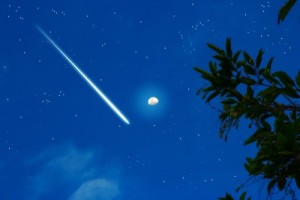
The Orionid meteor shower on October 17-25, 2013.
At maximum rates of 25 meteors per hour, expect a treat from October 17 through 25, with its peak on October 21 and 22.
Orionids are fast meteors, and we may see some fireballs with this event.
Easily Spotted
The meteors can be seen as elongated misty patches with the naked eye, and can be easily viewed through binoculars and backyard telescopes.
Look for the “W” formation of stars within Cassiopeia just to the left of Orion. Mars and Jupiter will be visible, too, 57 and 22 degrees above the eastern horizon in the early morning.
Orion
The Orionid meteor shower is the most dramatic meteor shower associated with Halley’s Comet. The Orionids appear to come from the constellation Orion, but they can be seen over a large area of the sky.
This meteor shower happens every year, and typically lasts for a week every October.
Halley’s Comet
When comets pass through our solar system, the Sun melts some of the ice, and rock particles break away from the comets. These particles continue on the comet’s trajectory and appear as meteors or “falling stars” when they pass through Earth’s upper atmosphere.
Halley’s comet created the Orionids, and has created many of the meteor showers that we see from Earth.
Dust off your telescopes, and have fun watching lots of beautiful objects in this October sky.

